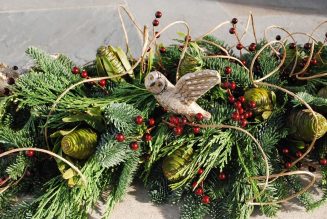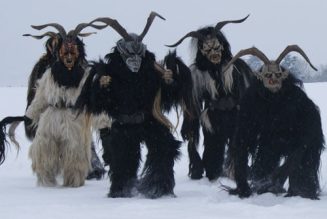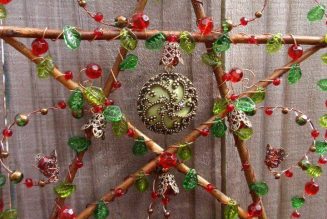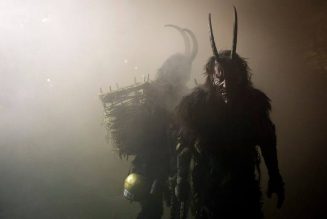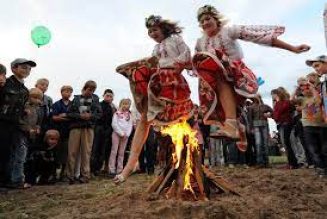
During the winter solstice season, we hear all kinds of cool stuff about candy canes, Santa Claus, reindeer and other traditions. But did you know that many Christmas customs can trace their roots back to Pagan origins? Here are ten little-known bits of trivia about the Yule season that you might be unaware of.
1. Christmas Caroling
The tradition of Christmas caroling actually began as the tradition of wassailing. In centuries past, wassailers went from door to door, singing and drinking to the health of their neighbours. The concept actually harkens back to pre-Christian fertility rites — only in those ceremonies, villagers travelled through their fields and orchards in the middle of winter, singing and shouting to drive away any spirits that might inhibit the growth of future crops. Caroling wasn’t actually done in churches until St. Francis, around the 13th century, thought it might be a nice idea.
2. Kissing Under the Mistletoe
Mistletoe has been around for a long time, and has been considered a magical plant by everyone from the Druids to the Vikings. The ancient Romans honoured the god Saturn, and to keep him happy, fertility rituals took place under the mistletoe. Today, we don’t quite go that far under our mistletoe (at least not usually) but it could explain where the kissing tradition comes from. The Norse Eddas tell of warriors from opposing tribes meeting under mistletoe and laying down their arms, so it’s certainly considered a plant of peace and reconciliation. Also in Norse mythology, mistletoe is associated with Frigga, a goddess of love – who wouldn’t want to smooch under her watchful eye?
3. Gift-Delivering Mythical Beings
Sure, we’ve all heard of Santa Claus, who has his roots in the Dutch Sinterklaas mythology, with a few elements of Odin and Saint Nicholas thrown in for good measure. But how many people have heard of La Befana, the kindly Italian witch who drops off treats for well-behaved children? Or Frau Holle, who gives gifts to women at the time of the winter solstice?
4. Deck Your Halls with Boughs of Green Things
The Romans loved a good party, and Saturnalia was no exception. This holiday, which fell on December 17, was a time to honour the god Saturn, and so homes and hearths were decorated with boughs of greenery – vines, ivy, and the like. The ancient Egyptians didn’t have evergreen trees, but they had palms — and the palm tree was the symbol of resurrection and rebirth. They often brought the fronds into their homes during the time of the winter solstice. This has evolved into the modern tradition of the holiday tree.
5. Hanging Ornaments
Here come those Romans again! At Saturnalia, celebrants often hung metal ornaments outside on trees. Typically, the ornaments represented a god — either Saturn, or the family’s patron deity. The laurel wreath was a popular decoration as well. Early Germanic tribes decorated trees with fruit and candles in honor of Odin for the solstice. You can make your own ornaments to bring the spirit of the season into your life.
6. Fruitcake
The fruitcake has become the stuff of legend, because once a fruitcake is baked, it will seemingly outlive everyone who comes near it. Stories abound of fruitcakes from winters past, magically appearing in the pantry to surprise everyone during the holiday season. What’s interesting about the fruitcake is that it actually has its origins in ancient Egypt. There’s a tale in the culinary world that the Egyptians placed cakes made of fermented fruit and honey on the tombs of their deceased loved ones – and presumably these cakes would last as long as the pyramids themselves. In later centuries, Roman soldiers carried these cakes into battle, made with mashed pomegranates and barley. There are even records of soldiers on Crusades carrying honey-laden fruitcakes into the Holy Land with them.
7. Presents for Everyone!
Today, Christmas is a huge gift-giving bonanza for retailers far and wide. However, that’s a fairly new practice, developed within the last two to three hundred years. Most people who celebrate Christmas associate the practice of gift giving with the Biblical tale of the three wise men who gave gifts of gold, frankincense and myrrh to the newborn baby Jesus. However, the tradition can also be traced back to other cultures – the Romans gave gifts between Saturnalia and the Kalends, and during the Middle Ages, French nuns gave gifts of food and clothing to the poor on St. Nicholas’ Eve. Interestingly, up until around the early 1800s, most people exchanged gifts on New Years’ Day – and it was typically just one present, rather than the massive collection of gifts that we’re inundated with each year in today’s society.
8. The Resurrection Theme
Christianity hardly has a monopoly on the theme of resurrection, particularly around the winter holidays. Mithras was an early Roman god of the sun, who was born around the time of the winter solstice and then experienced a resurrection around the spring equinox. The Egyptians honoured Horus, who has a similar story. While this doesn’t mean that the tale of Jesus and his rebirth was stolen from the cult of Mithras or Horus – and in fact, it’s definitely not, if you ask scholars – there are certainly some similarities in the stories, and perhaps some carryover from the earlier Pagan traditions.
9. Christmas Holly
For those who celebrate the spiritual aspects of Christmas, there is significant symbolism in the holly bush. For Christians, the red berries represent the blood of Jesus Christ as he died upon the cross, and the sharp-edged green leaves are associated with his crown of thorns. However, in pre-Christian Pagan cultures, the holly was associated with the god of winter – the Holly King, doing his annual battle with the Oak King. Holly was known as a wood that could drive off evil spirits as well, so it came in very handy during the darker half of the year, when most of the other trees were bare.
10. The Yule Log
Nowadays, when we hear about the Yule log, most people think of a deliciously rich chocolate dessert. But the Yule log has its origins in the cold winters of Norway, on the night of the winter solstice, where it was common to hoist a giant log onto the hearth to celebrate the return of the sun each year. The Norsemen believed that the sun was a giant wheel of fire which rolled away from the earth, and then began rolling back again on the winter solstice.

